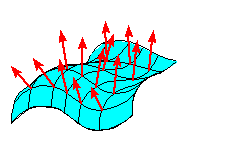Orientability and the Surface Normal
The unit surface normal is defined for a level surface by normalizing
the gradient. That is, if U(x,y,z) = k is a
level surface, then the unit surface normal is
If the level surface U(x,y,z)
= k has a parameterization r(u,v), then either n or -n for the level surface is the same
as the unit surface normal n defined in the previous section.
If n varies continuously across a surface U(x,y,z)
= k,
then we say that U(x,y,z)
= k is orientable. Intuitively,
orientability means that if the initial points of the unit surface normals n are placed on the surface, then their terminal points are all
on the same side of the surface.
If a surface is closed (such as a sphere), then we assume its orientation to
be with all normal vectors pointing toward the outside of the surface.
EXAMPLE 6 Explain why the surface z = x2cos(y) is
orientable.
Solution: Since z = x2cos( y) is the same as x2cos( y) -z = 0, we let U( x,y,z) = z-x2cos( y) , so that
|
ÑU =
á -2xcos( y), x2sin( y), 1
ñ |
|
Since the z-component of ÑU is 1, it is not possible for ÑU
to ever be 0. In fact, because the z-component of ÑU is positive, all the normal vectors are above the surface z = x2cos(y) .
|
| | n drawn to 1/4 scale |
|
Similarly, a parametric surface is orientable if n(u,v)
varies continuously across the surface and if n( u,v)
defines only one surface normal at each point on the surface. In particular, in
a surface of revolution, orientable means the unit normal is 2p-periodic
in q.
EXAMPLE 7 Find the
unit surface normal of the surface
| r( r,q)
= á rcos( q),
rsin(
q) ,cosh( r) ñ |
|
for q in [ 0,2p] and r
in [ 0, 1] . Explain why the surface is orientable.
Solution: Since rr = á
cos( q) ,sin( q) ,sinh( r)
ñ and rq
= á -rsin( q)
,rcos( q) ,0 ñ ,
their cross product is
|
|
|
| á
cos( q) ,sin( q)
,sinh( r) ñ×r
á -sin( q)
,cos( q),0 ñ |
|
|
|
|
| r
á - sinh( r) cos( q), -sinh( r) sin( q) ,1
ñ |
|
|
The square of the magnitude of the cross product is
|
|
|
| r2( sinh2(
r) cos2( q)+sinh2(
r) sin2( q) +1) |
|
|
|
|
|
|
|
|
|
|
Thus, ||rr×rq||
= rcosh( r) , so that the unit normal is
| n |
= |
|
|
|
|
|
= |
| r á -sinh(r)
cos( q), -sinh(r) sin( q)
,1 ñ
rcosh(
r) |
|
|
|
|
|
|
|
|
|
|
|
= |
 |
-sinh(r)
cosh(
r) |
cos( q)
, |
-sinh(r)
cosh(
r) |
sin( q)
, |
1
cosh(
r) |
 |
|
|
|
|
= |
á
-
tanh( r) cos( q), -tanh( r)
sin(q), sech(
r) ñ |
|
Since n( r,q) = á
-
tanh( r)cos(q), -tanh(r) sin(q),
sech(
r) ñ is continuous for all r and q,
and since n( r,q) is 2p-periodic,
the surface is orientable.
Not all surfaces can be oriented. For example, a Möbius strip, which can be
formed by twisting a strip of paper one half turn and pasting the two ends
together, cannot be oriented.
If normal vectors are drawn on the surface, then the half-twist means that there
will be a discontinuity in the assignment of unit normal vectors, or
equivalently, a sudden reversal of the direction of the normals where the
edges of the strip meet.
|
|
|
